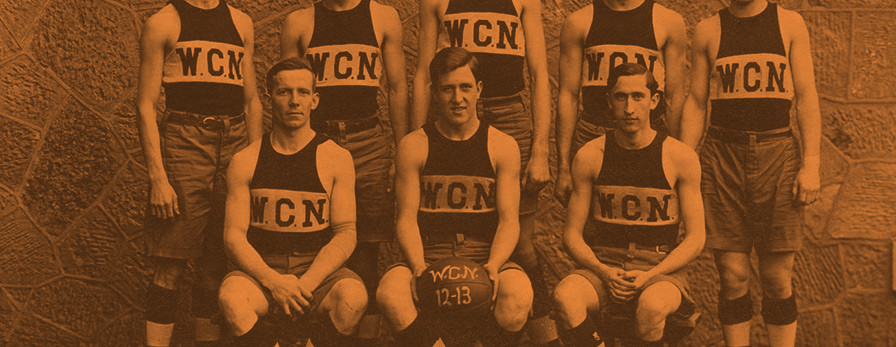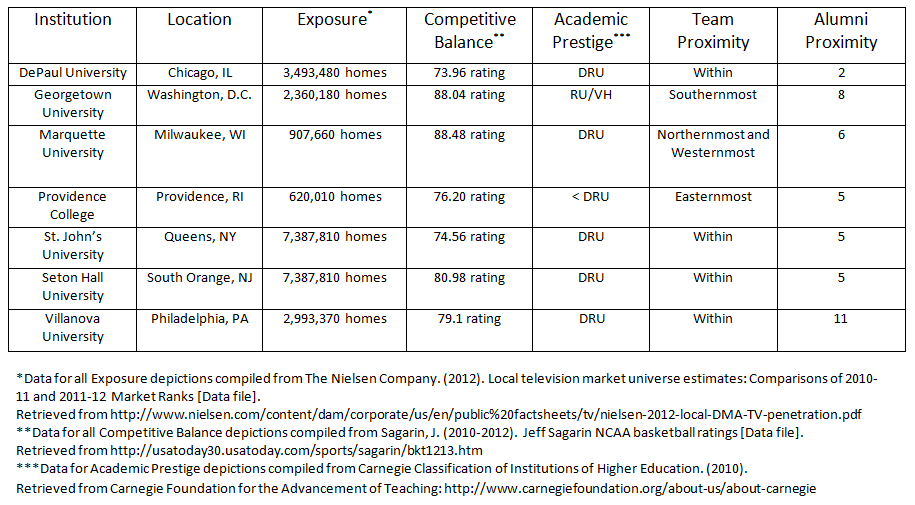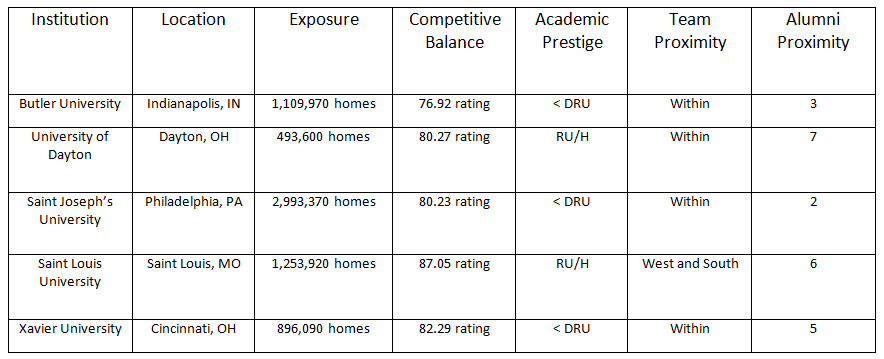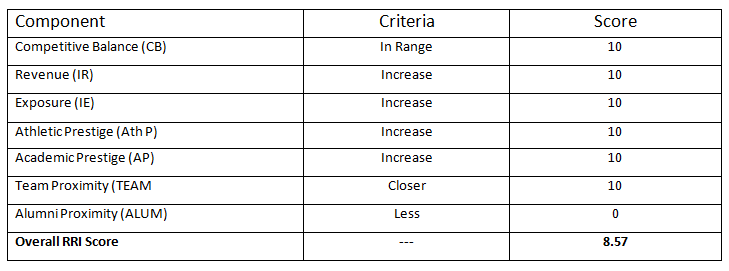By: G.K. Nwosu, Doctoral Student-University of Nevada Las Vegas; and Leon A. Jackson, Doctoral Student-University of Nevada Las Vegas.
This article applies the Realignment Rating Index (RRI)-as explained and discussed here (Pac-12 football, University of Colorado, and University of Utah) and here (Mountain West and Big 12 football)-to NCAA Division-I men’s college basketball. In this article, we examine the so called “Catholic Seven”, 1 who recently announced an intention to separate from the Big East Conference to pursue a new conference framework with basketball as its top sports property. 2 We will provide an examination of the seven institutions and a list of potential members that the Catholic Seven 3 may consider adopting in order to boost the contingent to a 12 member outfit. 4
I. The Catholic Seven
The seven faith-based institutions of the Big East have announced plans to depart the conference tentatively by 2015. 5 None of the seven schools associated with this transition currently offer FBS level football, thus men’s basketball appears to serve as the collective impetus towards realignment. These seven schools may look to utilize their basketball tradition, presence in top media markets, proud alumni bases, academic missions, and their religious connectedness as the foundation for establishing a viable basketball-laden athletic alliance. The Catholic Seven’s achievements include 85 NCAA tournament wins since 1980, nine Final Four appearances, five finals appearances, and two national championships. 6 The pioneers of this new alliance will potentially seek to add other institutions that fit their model of growth and development.
For the scope of this analysis, the areas of the RRI are illustrated below in Table-1. Institutional and conference financial data indicates that each of these schools earn approximately $1.5M in television/media broadcast revenue through their Big East Conference affiliation.
Table 1-The Catholic Seven
The Catholic Seven comprises members with a rich basketball tradition in top 50 United States media markets. Academically, they all have similar research agendas and are a tight geographical fit in the Eastern and Midwest United States. Expansion may help the group to enhance its profile as well as that of the individual member institutions. In the following section, potential candidates for expansion are vetted.
II. Introduction of Potential Institutions 7
Below, we present potential institutions inside and outside the Catholic Seven’s current geographic footprint. Five potential institutions for addition to the Catholic Seven (the “Catholic-12”) are outlined below in Table-2.
Table 2-Potential Institutions for Catholic Seven Expansion
From a basketball standpoint, each of these institutions have had success in the past, are experiencing a run of success, or both. 8 For example, the Butler program, which joined the Atlantic 10 Conference this year from the Horizon League, recently, enhanced its profile by reaching back-to-back NCAA Finals in 2010 and 2011. In the last 10 years, the Dayton Flyers basketball program has won a number of pre/early season tournaments, has reached postseason play in each of the last five seasons, and has won a National Invitational Tournament (NIT). Saint Joseph’s basketball program has won 18 conference championships dating back to 1959 and has 19 NCAA tournament appearances to its credit. Saint Louis University basketball counts seven NCAA tournament appearances and four NIT championship game appearances on its resume. Since the 1982 season, Xavier basketball has posted fewer than 20 wins in a season on only nine occasions. 9
Based on this information, it may seem as if each of these schools would be strong candidates to help expand the Catholic Seven. However, conference realignment decisions are not relegated to just performance between the lines of play. Table 2 helps to provide a partial snapshot of what each school may provide relative to the dimensions of the RRI. Revenue is not listed as a dimension because any figure in that regard may be a function of the overall potential 12 institution grouping.
III. Results and Discussion
For an endeavor that seeks to identify potential members that may provide value to a conference, it is of importance that all parties involved set forth and operate by a set of institutional ambitions. For the purpose of this analysis, the authors are operating under the assumption that the Catholic Seven grouping is looking to align with institutions which can help to ensure athletic parity, expand into large neighboring markets, increase the athletic profile of the conference, maintain a similar level of academia, and increase the grouping’s reach with its various alumni/booster groups. The group can expect that a result of expanding into larger, neighboring markets may increase travel but there also may be additional value in an increased geographic footprint. Table- 3 illustrates how the Catholic Seven stands before and after potential expansion.
Table 3- Catholic Seven: Pre and Post Expansion
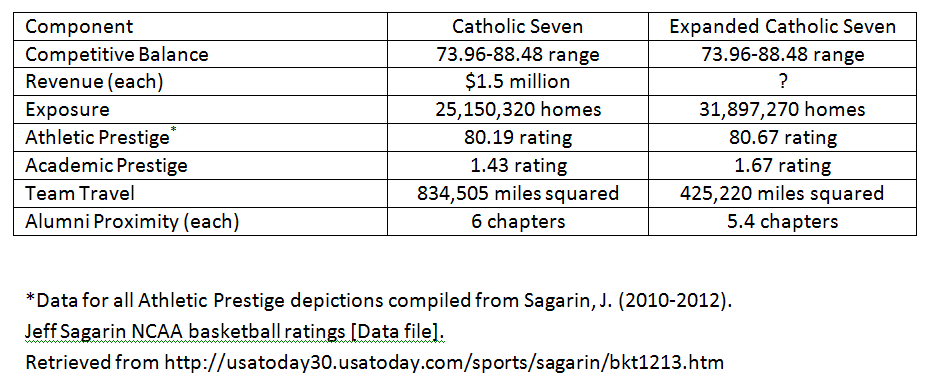 The addition of Butler, Dayton, Saint Joseph’s, Saint Louis, and Xavier would allow the new Catholic-12 to experience a similar level of parity which should help with fan interest and television broadcast/media rights negotiations. Because of the conceptual nature of this analysis, types of revenue drawn from any television broadcast/media rights packages are outside its scope. The Catholic-12 does encompasses over 30 million television viewing homes and, as a measure of Athletic Prestige, the Catholic-12 is a slightly stronger overall conference than the Catholic Seven. Each of these components may provide leverage in television broadcast/media rights negotiations.
The addition of Butler, Dayton, Saint Joseph’s, Saint Louis, and Xavier would allow the new Catholic-12 to experience a similar level of parity which should help with fan interest and television broadcast/media rights negotiations. Because of the conceptual nature of this analysis, types of revenue drawn from any television broadcast/media rights packages are outside its scope. The Catholic-12 does encompasses over 30 million television viewing homes and, as a measure of Athletic Prestige, the Catholic-12 is a slightly stronger overall conference than the Catholic Seven. Each of these components may provide leverage in television broadcast/media rights negotiations.
From an academic standpoint, both the Catholic Seven and the Catholic-12 remain relatively the same in terms of research activity. The Catholic-12 group increases exposure for the conference in terms of viewership, while claiming the 26th, 63rd, 21st, and 35th local television markets. 10 The addition of Saint Joseph’s (Philadelphia) would also give the Catholic-12 an additional outlet in the country’s fourth largest market. This is of particular interest because the Catholic-12 actually decreases its footprint in terms of square miles but experiences benefits associated with the opposite. The Catholic-12 loses little ground in terms of alumni/booster presence. A summary of the Catholic Seven/Catholic-12 Realignment Rating Index score is depicted below in Table-4.
Table 4-Catholic Seven/Catholic-12 Realignment Rating index Score
IV. Limitations & Conclusion
It would appear that the inclusion of the five institutions 11 identified would allow the Catholic Seven grouping to realize benefit in virtually all dimensions of the Realignment Rating Index (RRI). The analysis in this regard is somewhat limited because it essentially only provides a baseline for comparison. Better prediction power may be gained through looking at other institutions and groupings that may “fit” the identity and ambitions of the Catholic Seven and comparing these groupings against one another. For example, institutions like the University of Notre Dame, Creighton University, and Temple University were not included in this analysis and could possibly be better fits. Of course, a multitude of circumstances permeates around each school and/or their respective conferences, but they would seem to be closely aligned in terms of fit with the schools highlighted in this analysis.
Both future and practical research may take a qualitative component into consideration such as overall ambitions and the weighting of each RRI component. This analysis, as well as future analyses, may be strengthened by providing a longitudinal snapshot of institutions relative to each component. For example, a basketball program may have had a stellar five-year run and then experienced decreased performance in year six. Utilizing Competitive Balance data from year six may not provide the full picture of that particular program’s value to a potential conference in that regard. A follow up study on this analysis will focus on one of the five institutions identified for expansion for the purposes of studying how it may or may not benefit from leaving its current conference for the new one presented in this analysis.
G.K. Nwosu is a doctoral student at the University of Nevada Las Vegas studying Higher Education Leadership. An alumnus of the University of Oklahoma (2007 and 2010), G.K.’s background and research interests include sports organization behavior and organizational change, particularly at the National Collegiate Athletic Association Division-I level. He can be reached at (702)-895-1468 or nwosug@unlv.nevada.edu.
Leon A. Jackson is a native of Indiana. He obtained his Bachelors of Science in marketing from Indiana State University in 2004. He obtained his Master’s degree in Education Leadership from the University of Nevada Las Vegas in 2009. He is currently pursuing his Ph.D. in Public Affairs with an emphasis in Workforce Development and Organizational Leadership at UNLV. His research interests include Social Capital, Self-regulated/Informal Learning, and Leadership through Experience, Mentoring, Capacity Building, and the Non-profit sector. He can be reached at (702)-774-4146 or leon.jackson@unlv.edu.
Key Insights
We take a look at the Catholic Seven using the Realignment Rating Index with proposed additions of Butler, Dayton, Saint Joseph’s, Saint Louis, and Xavier. The examination found that the new group (Catholic-12) would expect to experience a similar level of parity which should help with fan interest and television broadcast/media rights negotiations. From an academic standpoint, both the Catholic Seven and the Catholic-12 remain relatively the same in terms of research activity. The Catholic-12 loses little ground in terms of alumni/booster presence.
References:
- DePaul University, Georgetown University, Marquette University, Providence College, St. John’s University, Seton Hall University, and Villanova University. ↩
- Auerbach, N. (2012, December 16). ‘Catholic seven’ announce official departure from Big East. USA Today: Sports. Retrieved from http://www.usatoday.com/story/sports/ncaab/2012/12/15/catholic-7-announce-official-departure-from-big-east/1771579/ ↩
- Although the Catholic Seven Moniker implies the institutions in this group are faith-based in Catholicism, potential institutions may not. However, each proposed institution does demonstrate an affiliation with a Christian denomination or were at least established as such. ↩
- The authors analyzed the current landscape of NCAA Division-I men’s basketball and determined that the mean number of institutions per conference to be approximately 11. Therefore, for sake of balance, the assumption in this article is that the Catholic Seven may expand to 12 institutions. ↩
- Auerbach, N. (2012, December 16). ‘Catholic seven’ announce official departure from Big East. USA Today: Sports. Retrieved from http://www.usatoday.com/story/sports/ncaab/2012/12/15/catholic-7-announce-official-departure-from-big-east/1771579/ ↩
- The Big East Conference (2013). Big East Conference member schools. Big East Member Schools. Retrieved from http://www.bigeast.org/AbouttheBIGEAST/FutureMembership.aspx ↩
- Due to the conceptual nature of this analysis, a few assumptions are made by the authors. The research does not control for all strategic motives. For example, it is not known whether the Catholic Seven grouping wants to expand into new, emerging regions or not. ↩
- While outside the scope of the RRI as presented in this article, we do recognize that realignment is complex from an economic viewpoint, including how teams are compensated in Units for reaching the NCAA Tournament and what that value means to conferences – both suitors and predecessors.” For instance, see: http://sportsillustrated.cnn.com/college-basketball/news/20121213/big-east-basketball/#ixzz2IlRuSeG9 ↩
- The Atlantic 10 Conference (2013). About Atlantic 10. Atlantic 10 Conference members. Retrieved from http://www.atlantic10.com/about/institutions.html ↩
- Comparisons of 2010-11 and 2011-12 Market Ranks [Data file]. Retrieved from http://www.nielsen.com/content/dam/corporate/us/en/public%20factsheets/tv/nielsen-2012-local-DMA-TV-penetration.pdf ↩
- It is also not clear what specific motives persist. For example, it could be the case that the grouping does not want to expand or maybe even wants to expand beyond 12 institutions. Of course, more institutions means more teams, which means more games to present to television networks which could increase the value of any broadcast/media agreements. These types of motives and ambitions are outside the scope of this analysis and the RRI as a tool. ↩

